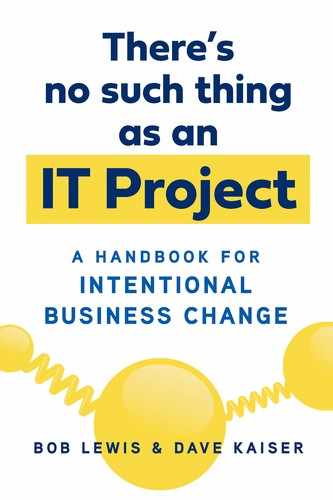Epilogue
![]()
A Few Last Words
Our ability to adapt is amazing. Our ability to change isn’t quite as spectacular.
—Lisa Lutz
There you have it. To make change happen, all you gotta do is . . . well, first of all you have to ignore any and all advisers who start their pitch with “All you gotta do is . . .”
As you can see if you’ve made it through, “all you gotta do” is a dangerous message. Modern businesses are complex. They’re complex externally, where their decisions about products, services, pricing, customer targeting, selection of vendors and partners, and branding and messaging all have to come together.
They’re complex internally, too, as employees and contractors:
• Participate in business processes using the tools IT provides.
• Receive work direction from whoever they currently report to in a world of continuous reorganizations.
• Make decisions in large part as a consequence of the unconscious assumptions and habits reinforced by the business culture they’re immersed in.
While there are any number of “all you gotta do” panaceas out there, promising to make it all simple, when it comes to organizational change, simplicity is wishful thinking.
Trend-spotting readers might wonder why we didn’t spend much time or place much emphasis on Digital, either as a noun or as an adjective. It’s a reasonable question, given that while “Digital” is used far more often than it’s defined, it’s nonetheless quite important to the future of most businesses.
Ignoring the multitude of definitions, what makes Digitality particularly important is its intense focus on increasing revenue rather than on decreasing costs as strategy’s primary imperative, and, as a consequence, its equally intense focus on enhancing the customer experience rather than on increasing internal process efficiencies even when it’s to the customer’s detriment.
So while we didn’t intersperse “Digital” throughout the book you just read, we trust you’ll recognize that this sort of thinking perfuses it. We didn’t emphasize things Digital for a simple reason: all Digital business changes are business changes, but not all business changes are Digital.
Both of us have led business changes of various sizes and scopes, participated in more, and been observers of no small number of them besides. Some of the changes were more successful than others. Which were the more important sources of insights for this book is open to question.
What is fair to say is that making change happen is hard. It’s hard the way neurosurgery is hard; it’s also hard the way digging a ditch is hard.
A common metaphor is that it’s like replacing an engine on an airplane while the airplane is in flight. It’s a reasonable description of most of the changes we’ve been involved in.
When leading change, most days felt like we were taking the proverbial two steps forward to one step back, but there was no shortage of days that reversed the numbers.
Not to mention the many occasions in which we heard participants take great pride in a recent accomplishment, only to discover their “accomplishment” was based on a completely flawed understanding of what we had in mind. Their flawed understandings usually resulted from a cultural mismatch, which is to say their perceptions about what we had in mind were as much a reflection of their own unconscious preconceptions as of our explanations.
This book is a prime example. As we’ve discussed the premise with colleagues, friends, and clients we’ve found ourselves colliding with preconceptions over and over again: “There’s no such thing as an IT project,” we explain, continuing, “It’s always about business change or there’s no point to it.”
“We’re way ahead of you,” we hear in response. “We make sure every project we undertake delivers business benefit.”
We hope we’ve made the point clearly and with no more repetition than necessary that business benefit isn’t the same as intentional business change. Yes, of course the intended business changes should be beneficial. But no, if the project is defined in terms of delivering software, using the software to make business change happen will be Someone Else’s Problem.
And that Someone might not see it that way.
We have, on occasion, found ourselves explaining the challenges of management, leadership, and making change happen to technical professionals promoted into leadership, management, and project management roles.
Our metaphor for the situations they’ve found themselves in is that they should view the organization they manage as a computer that has a glitchy operating system and buggy programming language.
They still have to program the sucker, which means finding workarounds for all the glitches and bugs.
Only when it comes to an organization, the glitches and bugs are the idiosyncrasies of those pesky human beings who populate it.
The other point we make is that we recognize the satisfaction that comes from writing a computer program that does something useful.
It’s a satisfaction that pales in comparison with successfully achieving intentional organizational change.
Which brings us back to the design and implementation of a swing—the metaphor we used to start this handbook of organizational change.
We hope you see the differences. Not only the differences between all the miscommunications that can happen when every step of swing design doesn’t keep why anyone might want a swing firmly in mind. But also the differences between delivering a swing, no matter how well designed and constructed, and your kids and their friends actually playing on it and around it.
Now that you understand the differences, you’re ready to make intentional business change happen.
